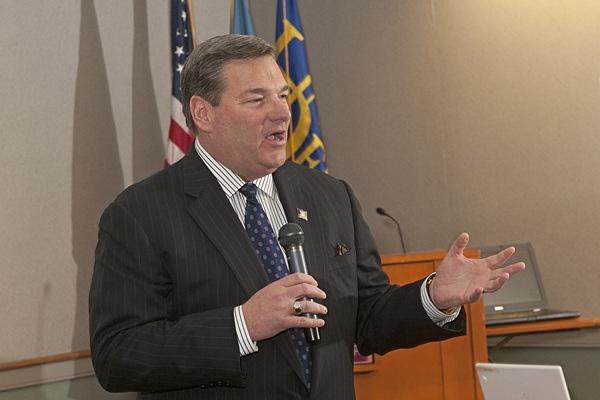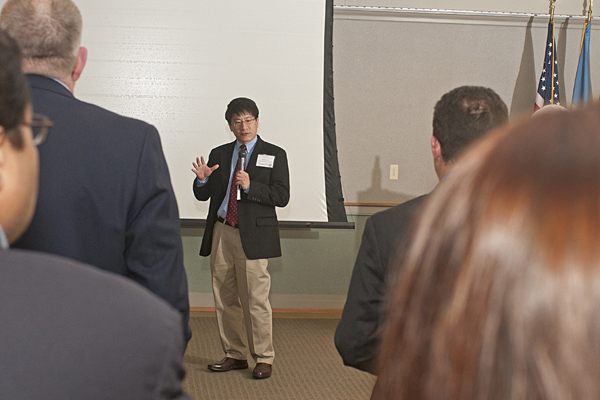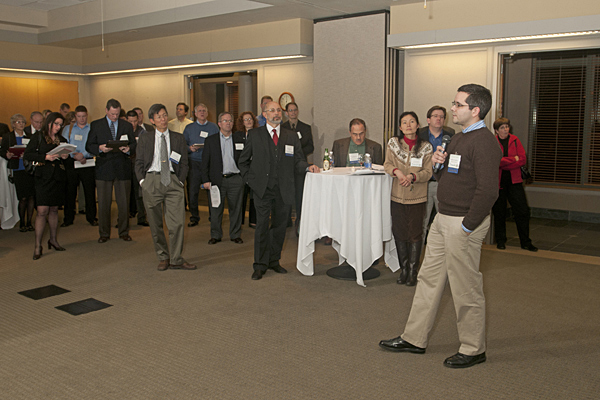


CAT Connect
Event links members of Delaware bioscience community
8:50 a.m., Jan. 18, 2012--Kelvin Lee’s day jobs are director of the Delaware Biotechnology Institute (DBI) and Gore Professor of Chemical Engineering at the University of Delaware, but on Thursday, Jan. 12, he found himself playing matchmaker to other scientists and engineers in the bioscience community.
That evening at DBI, Lee hosted CAT Connect, a forum for academic and industry scientists seeking to partner with others in the field. The event marked the launch of the Delaware Bioscience Center for Advanced Technology (CAT), which synergizes efforts among the various life science communities in Delaware.
Campus Stories
From graduates, faculty
Doctoral hooding
Some 80 people representing colleges and universities, laboratories, companies, research institutes, high schools, state agencies, and health care organizations in the First State turned out for the event.
Alan Levin, director of the Delaware Economic Development Office, opened the program, referring to Lee as “a huge catalyst for the state.”
“Delaware is on its way back, and clearly one of the most important parts of economic development is bioscience research,” Levin said. “We’re proud to support this launch—you’re creating the entrepreneurs and businesses of tomorrow. We believe in what you’re doing, and I’ll be happy to help make your dreams a reality because when your dreams become a reality, Delaware’s dreams become a reality.”
Lee said that the inspiration for the Bioscience CAT came from similar activities in other states, but he emphasized strengths in Delaware that make the state a particularly favorable place for high-tech partnerships, including a strong base of scientists and a business-friendly climate.
Levin and Lee were brief in their introductory remarks, but the 25 presenters were even briefer. The speakers had just one minute and one slide each to make their pitches to the participants in areas ranging from medicine and materials to pigments and power generation.
Ron Smith of Thornley Company, a maker of specialty chemicals, may have summed up the goal of the event for everyone when he said, “We’re here looking for technology as much as we’re here to advocate our own technology.”
Presenters offered technical expertise, help with navigating regulatory processes, advanced instrumentation capabilities, assistance with technology commercialization, and student intern support.
From Lee’s perspective, the first-time event was a success. Following the “formal” presentations, the attendees had the opportunity to chat informally with the speakers and each other. If the buzz in the room was any indication, they were all connecting.
Mike Bowman, chairman and president of the Delaware Technology Park , said he enjoyed seeing the energy generated at the event.
“The Delaware Biotechnology Institute combined the best of science and innovation in the academic and private sectors with a current trend in speed pitching for matches,” he said. “It was a most productive information and networking experience thanks to the leadership of Director Kelvin Lee to secure a State grant program.”
About the Bioscience CAT
The Delaware Bioscience Center for Advanced Technology (Bioscience CAT) was formed in 2011 under the aegis of the Delaware Biotechnology Institute to synergize efforts among the academic and industrial life science communities in the state through technology access, grants, and a symposium.
With support from the state of Delaware, the Bioscience CAT provides grant opportunities to faculty and investigators who are working collaboratively with Delaware bioscience businesses, including those that are members of the Delaware BioScience Association.
In addition, the CAT provides easier access to high-end instrumentation platforms available within the academic community at the University of Delaware.
Article by Diane Kukich
Photos by Duane Perry










